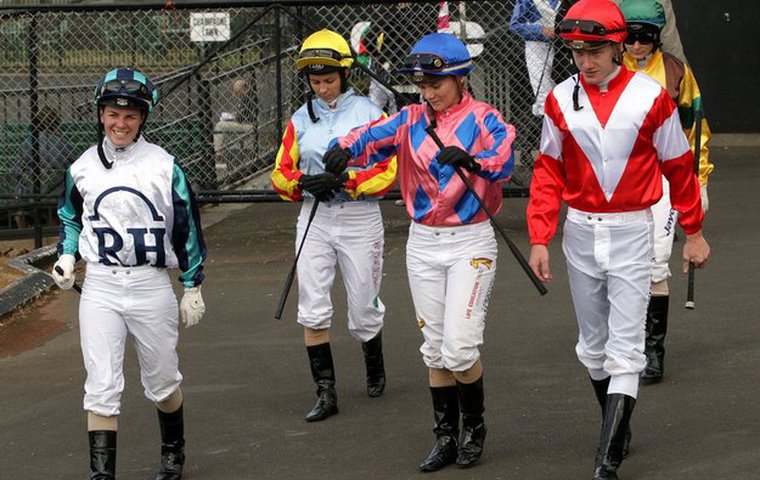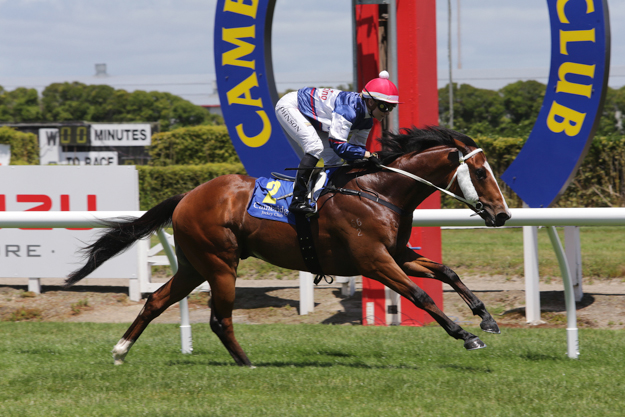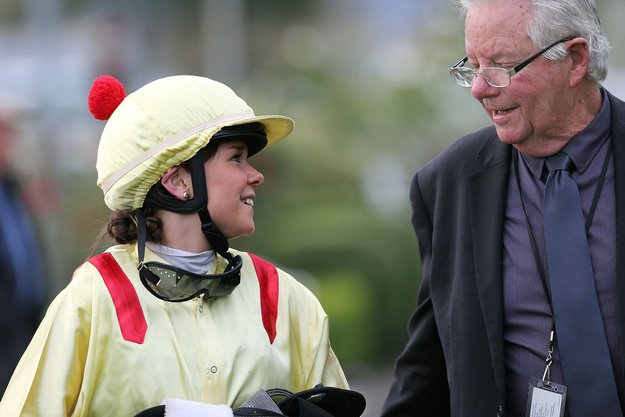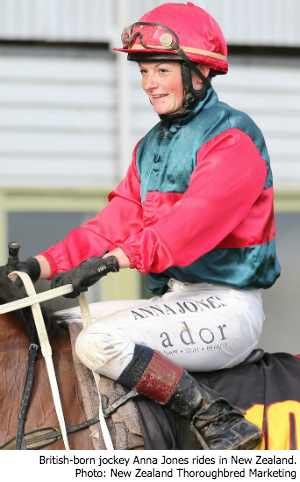
Female jockeys are nothing unusual across the world’s racing jurisdictions. However, in New Zealand, the sheer number of female jockeys - more than 40 percent of the country’s total riding colony - makes for a unique racing environment. Kevin Robertson meets some of New Zealand’s leading up-and-coming hoops that also happen to be women, in one of the most equal-opportunity-driven racing scenes in our sport.
Danielle Johnson was born to be a jockey. Her father was one of New Zealand’s leading riders for more than four decades, and her mother is a licensed trainer, so the signs were all there from an early age that a career within Thoroughbred racing was inevitable. In just her fifth season as a senior rider, the engaging and modest 23-year-old is currently on top of the New Zealand jockey’s premiership. Yet it has been less than 40 years since women in this country were granted the right to hold a professional jockey licence.
Female riders are so much a part of New Zealand’s racing landscape now that it’s hard to imagine the industry without them. Of the 194 registered riders in the country, 81 are female, including 29 apprentices that now outnumber their 26 apprenticed male counterparts. New Zealand’s race-riding has taken on a distinctly feminine tilt, but it wasn’t always that way.
During the late 1960s and early 1970s, women were allowed to ride only in non-betting races reserved especially for them, in contests with names such as the “Powder Puff Derby.” The mostly male racing administrators proved very reluctant to go any further than that. But in September 1976, Linda Jones of Cambridge became the first woman to apply for an apprentice-jockey’s licence, and she was refused, owing to being “too old, married, and not strong enough.” It mattered little that Jones had won the inaugural Qantas International Women’s Handicap at Rotorua the year before (during International Women’s Year), and was considered by many to be the best female rider in the country.
After significant pressure from senior racing journalist John Costello, several progressive racing clubs, and a determined group of women riders across New Zealand, in July 1977, the New Zealand Racing Conference finally approved the licensing of women riders. It was somewhat inevitable that Jones would rapidly emerge as a star of the country’s national scene.
Apprenticed to her husband, trainer Alan Jones, in 1977, Linda Jones had her first professional ride in August 1978. She rode six winners in the first five weeks of that season, which saw the beginning of a stunning season of firsts.
Jones was the first woman in the Southern Hemisphere to ride four winners in a day. She was the first woman to compete in the Auckland, Sydney, and Wellington Cups. She was the first woman in Australasia, Europe, and North America to ride a Derby winner, piloting Holy Toledo to victory in the 1979 Wellington Derby. And she was the first woman to ride a winner against professional male jockeys at a registered race meeting in Australia. The latter came when she rode Pay The Purple to victory in Brisbane in May 1979.
Linda Jones’s success opened the floodgates for women riders in New Zealand, and the milestones began to accumulate.

New Zealander Dianne Moseley became the first female jockey to win a G1 race in Australia, riding Double You Em to victory in the Fourex Cup at Doomben in July 1982. Maree Lyndon became the first female to win a major cup race when she rode Lord Reims over the line in the Adelaide Cup of 1987. That same year, Lyndon was the first female rider to ever compete in a Melbourne Cup.
Over the years, names like Debbie Healey, Linda Ballatyne, Lee Rutherford, and Cathy Tremayne (who once rode six winners on the card) were all prominent, but it wasn’t until the 2004/05 racing season that a female rider sat at the top of the national jockey’s premiership ladder for the most wins in a season. It was achieved by the controversial Lisa Cropp (who has been embroiled in positive drug charges), and Cropp went on to win the premiership on three consecutive occasions from 2005 after a successful international stint in Australia and Macau.
In 2012, Lisa Allpress became the second female in New Zealand to win the premiership before broadening her career with an ongoing assignment in Singapore, where she is currently among the top 10 riders in that jurisdiction. Danielle Johnson believes that the example set by riders like Allpress helps drive her to succeed in what is still a mainly male industry.
“I look at what the other girls like Lisa have achieved, and are continuing to achieve, and it motivates me to keep working hard,” Johnson said. “While the male riders, and people like my dad, have been good at offering advice, the opportunity to sit and talk with people like Lisa, [fellow female rider] Sam Spratt, and the other senior girls who have so much experience, has been of massive benefit to me.”
The environment of equality in which Johnson operates within the New Zealand racing scene has become a major attraction for a number of emerging female riders from international jurisdictions, from places where the opportunities to ride racing Thoroughbreds are not as great. The Swedish-born Ulrika Holmquist made her way to New Zealand two years ago after securing a track-riding position with the powerful Murray Baker stable in Cambridge. Holmquist had graduated from the British Racing School in Newmarket, and the move halfway around the world was part of fulfilling a childhood ambition to become a jockey.

“I’m from Gothenburg in Sweden, and I fell in love with horses when I was little after I was taught to ride,” Holmquist said. “Our family isn’t a racing one. My parents are both lawyers, but when I was seven my dad took me to the local racetrack that was being built and we raced up the home straight with me on his shoulders. I think it was right then that I set my goal to become a jockey, and to return home to Sweden one day to win a race on that track.”
After an eight-month stint at the Baker stable, Holmquist did return home, but the lure of the warm New Zealand environment and the potential to further her riding ambitions saw her return after just a few months.
“I really missed New Zealand, so I decided to come back and see if I could get an apprenticeship, which I did. Things have progressed from there,” she said. “The opportunities in New Zealand are just so good. There is really no way I could be where I am now back at home or in England, as women jockeys there are seen as being too weak to compete against the men, whereas that attitude doesn’t seem to exist here.”
For British-born Anna Jones, it’s a similar story. She also graduated from the British Racing School, but unlike Holmquist, she was a Newmarket native with family ties to the local Glebe Stud. The choice of an industry career was therefore a logical one. 
“I actually wanted to become a vet but my grades weren’t good enough,” Jones said, “so I went to the Racing School before making a decision on what I wanted to do next. I was really lucky in that a friend of mine had a connection with Valachi Downs Stud in the Waikato [New Zealand], and they were looking for staff, so I applied and got a job with them preparing yearlings for the annual sales.”
Jones began to ride a little bit of trackwork while working at the stud, and when her job finished she was offered a full-time stable position with New Zealand trainer Karen Fursdon. With that offer came a riding apprenticeship – if she could get her weight down to 50 kilograms.
“I did within six months, and I haven’t looked back,” she said.
Jones rode her first winner in June 2013 at Te Teko Racecourse, piloting the horse Sir Elmo for Valachi Downs owner Kevin Hickman. The 22-year-old apprentice has become a popular fixture among New Zealand’s riding ranks.
“I know that if I was back at home I just couldn’t get the same chances as I have here,” she said. “I love it in New Zealand, and it gives me the chance to buy a house and set myself up for the future. I know I couldn’t do that back home, although I do hope that one day I can go back and ride to show them that women riders are the equal of the men, and can compete and win against them.”


